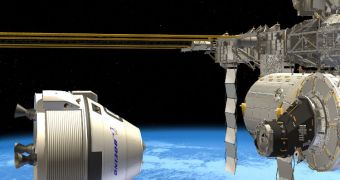Officials with the Defense, Space & Security (BDS) Division at the Boeing Company announce that their spacecraft, dubbed CST-100, has passed a critical review test recently. A Launch Abort System that will go on the vehicle has been successfully tested in the United States, the representatives say.
The assessments were conducted by engineers with Pratt & Whitney Rocketdyne, one of the most renowned rocket engine companies in the industry today. Its teams analyzed the functionality of the Bantam demonstration engine that will go on the CST-100.
This engine will power the LAS that will be outfitted on the Boeing spacecraft. The launch abort system is a critical safety feature that NASA insists on seeing on all space vehicles competing for the chance to take its astronauts to low-Earth orbit.
The American space agency has entrusted its future to commercial crew transportation, deciding to fund companies such as Boeing, SpaceX, Orbital Sciences Corp. and others in their effort to produce private spacecraft capable of reaching LEO.
CST-100 is one of those contenders, and Boeing wants to make sure that it secures some level of NASA funding. However, the money can be achieved only if critical review tests are passed with flying colors.
An important component of the review process is the LAS, an instrument that is worth nothing without good rocket motors. Its job is to separate the spacecraft away from its carrier rocket in case of an emergency, and to take the crew as far from the delivery system as possible.
It's critical for the engines doing this to be extremely well calibrated and powerful, so as to ensure the astronauts' survival. NASA will not accept any entry below its minimum requirements, which are fairly severe, experts in the private space industry agree.
“The successful engine test series was Boeing's last major milestone under our current Commercial Crew Development Space Act Agreement with NASA. It validates our technical approach for a pusher launch abort system,” explains Keith Reiley.
“With this system, we can use the abort fuel to re-boost the space station orbit, which is an added benefit to NASA and Bigelow Aerospace,” adds the official, who is the deputy program manager for Commercial Crew programs at Boeing.
“This is a significant step in our plan to provide safe, reliable and affordable crew and passenger transportation to the International Space Station and other low-Earth orbit destinations,” he argues, quoted by SpaceRef.
Officials at Pratt & Whitney Rocketdyne were equally as enthusiast about the success of the new tests, which were carried out at a new research facility in the California desert.
“The engine performance was stable during the full-duration tests, achieving 52,000 to 54,000 pounds of thrust, and the hardware was in excellent condition after the tests,” explains Terry Lorier, who is the manager of the Bantam program at the company.
“We are extremely pleased with the latest test demonstration's rapid success in validating a key element of Boeing's launch abort system, and look forward to continuing our partnership with Boeing in pursuit of the next-generation, commercial human-rated spacecraft,” he concludes.

 14 DAY TRIAL //
14 DAY TRIAL //